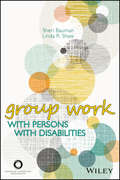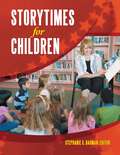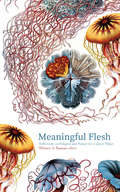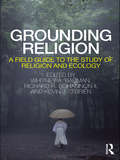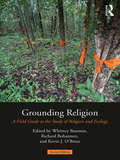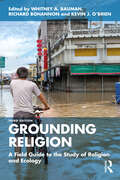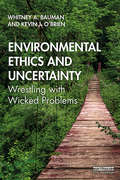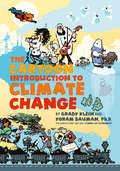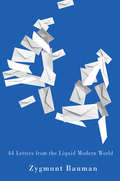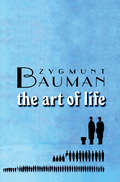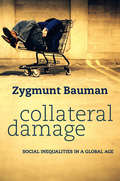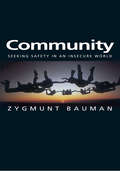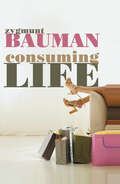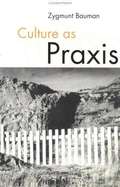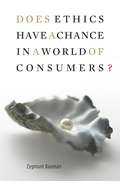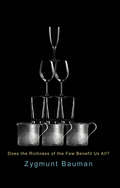- Table View
- List View
Group Work With Persons With Disabilities
by Sheri Bauman Linda R. ShawThis one-of-a-kind manual provides direction for leading groups of people with disabilities or groups that have members with disabilities. Viewing disability as a single aspect of a multifaceted person, Drs. Bauman and Shaw share their insight and expertise and emphasize practical skill building and training for facilitating task, psychoeducational, counseling, family, and psychotherapy groups across various settings. Topics examined in Part I include common themes in groups that focus on disability; various group formats, including groups using technological platforms; issues of diversity that exist simultaneously with ability; group composition; ethical concerns; and training considerations and logistical accommodations. Part II focuses on group counseling with clients experiencing sensory, psychiatric, cognitive, and physical disabilities as well as chronic medical conditions. A list of resources, support information, and group exercises completes the book. *Requests for digital versions from the ACA can be found on wiley.com. *To request print copies, please visit the ACA website here. *Reproduction requests for material from books published by ACA should be directed to permissions@counseling.org
Storytimes for Children
by Stephanie G. BaumanThis text presents a compilation of the best of ideas from a group of library science graduate students, providing creative and engaging programs geared especially for children ages 0–12.What are the concepts, activities, and topics that will hold the attention of today's children? And what are the best ways to provide a valuable learning experience while they're having fun and being entertained?Many of the most original, creative, and wildly effective ideas in storytime are contained in Storytimes for Children, a collection of fresh and vibrant programs created to be relevant, interesting, and fun for today's youngest generations. This collection of themed storytimes includes suggestions for opening and closing sessions; crafts and activities; songs, poems, fingerplays, and movements; as well as the accompany literature. Several of the included storytimes comprise a series of programs, allowing for related activities that build upon each other. The text is organized into six chapters, each prefaced by an introduction that clarifies the strengths of the programs within. Each chapter covers a highly targeted age range to give practitioners the ability to easily choose the most appropriate storytimes for any given audience.
Meaningful Flesh: Reflections on Religion and Nature for a Queer Planet (PDF)
by Whitney BaumanReligion is much queerer than we ever imagined. Nature is as well. These are the two basic insights that have led to this volume: the authors included here hope to queerly go where no thinkers have gone before. The combination of queer theory and religion has been happening for at least 25 years. People such as John Boswell began to examine the history of religious traditions with a queer eye, and soon after we had the indecent theology of Marcella Althaus Ried. Jay Johnston, one of the authors in this issue, is among those who have used the queer eye to interrogate authority within Christian theological traditions. At the same time, there have been many queer interrogations of “nature,” perhaps most notably in the works of Joan Roughgarden and Ann Fausto-Sterling, and more recently in the works of Catriona Sandilands and Timothy Morton (an author in this volume). However, the intersections of religion, nature, and queer theory have been largely left untouched. With the exception of Dan Spencer, who writes the introduction for this volume and is one of the early pioneers in this realm of thought with his book Gay and Gaia (Pilgrim Press, 1996), and the work of Greta Gaard in developing a queer ecofeminist thought, religion and nature, or religion and ecology, have largely ignored the realm of queer theory. In part, the blinders to queer theory on the part of eco-thinkers (religious or otherwise) are similar to the blinders eco-thinkers have when it comes to postmodern thought in general: namely, if there are no absolute foundations, how does one create an environmental ethic and a “nature” to save? For this reason and many others, this volume on religion, nature, and queer theory is groundbreaking. Though these essays span many different disciplines and themes, they are all held together by the triple focus on religion, nature, and queer theory. Each of these essays offers a unique contribution to the intersection of religion, nature, and queer theory, and all of them challenge strict boundaries proposed in religious rhetoric and many discourses surrounding “nature.” Carol Wayne White’s essay draws from a queer reading of James Baldwin to develop an African American religious naturalism, which highlights humans as polyamorous bastards. Jacob Erickson’s essay examines Isabella Rossellini’s “Green Porno” and Martin Luther’s work to develop an irreverent theology. Jay Johnston draws from personal relationships with his late dog, and Master/Pup fetish-play to blur the boundaries between humans and other animals, specifically within ethical and theological discourse. Whitney Bauman reflects on how the very processes of globalization and climate change queer our identities and call for a queer and versatile planetary ethic. Finally, Timothy Morton leads us through a reflection on queer green sex toys to challenge the ontology of agrologistics. Each of these essays in their own way is concerned with fleshing out more meaningful encounters with the planetary community. Without being too ambitious, we hope that these sets of essays will help to open up a new trajectory of conversations at the intersection of religion, nature, and queer theory.
Grounding Religion: A Field Guide to the Study of Religion and Ecology
by Whitney A. Bauman Richard Bohannon Kevin J. O'BrienHow do religion and the natural world interact with one another? Grounding Religion introduces students to the growing field of religion and ecology, exploring a series of questions about how the religious world influences and is influenced by ecological systems. Grounding Religion examines the central concepts of ‘religion’ and ‘ecology’ using analysis, dialogical exchanges by established scholars in the field, and case studies. The first textbook to encourage critical thinking about the relationships between the environment and religious beliefs and practices, it also provides an expansive overview of the academic field of religion and ecology as it has emerged in the past forty years.? The contributors introduce students to new ways of thinking about environmental degradation and the responses of religious people. Each chapter brings a new perspective on key concepts such as sustainability, animals, gender, economics, environmental justice, globalization and place. Discussion questions and contemporary case studies focusing on topics such as Muslim farmers in the US and Appalachian environmental struggles help students apply the perspective to current events, other media, and their own interests.?
Grounding Religion: A Field Guide to the Study of Religion and Ecology
by Whitney A. Bauman Richard Bohannon Kevin J. O'BrienHow do religion and the natural world interact with one another? Grounding Religion introduces students to the growing field of religion and ecology, exploring a series of questions about how the religious world influences and is influenced by ecological systems. Grounding Religion examines the central concepts of ‘religion’ and ‘ecology’ using analysis, dialogical exchanges by established scholars in the field, and case studies. The first textbook to encourage critical thinking about the relationships between the environment and religious beliefs and practices, it also provides an expansive overview of the academic field of religion and ecology as it has emerged in the past forty years.? The contributors introduce students to new ways of thinking about environmental degradation and the responses of religious people. Each chapter brings a new perspective on key concepts such as sustainability, animals, gender, economics, environmental justice, globalization and place. Discussion questions and contemporary case studies focusing on topics such as Muslim farmers in the US and Appalachian environmental struggles help students apply the perspective to current events, other media, and their own interests.?
Grounding Religion: A Field Guide to the Study of Religion and Ecology
by Whitney A. Bauman Richard Bohannon Kevin J. O'BrienNow in its second edition, Grounding Religion explores relationships between the environment and religious beliefs and practices. Established scholars introduce students to the ways in which religion shapes human–earth relations, surveying a series of questions about how the religious world influences and is influenced by ecological systems. Case studies, discussion questions, and further reading enrich students’ experience. This second edition features updated content, including revisions of every chapter and new material on natural disasters, gender and sexuality, race and ethnicity, climate change, food, technology, and hope and despair. An excellent text for undergraduates and graduates alike, it offers an expansive overview of the academic field of religion and ecology as it has emerged in the past fifty years.
Grounding Religion: A Field Guide to the Study of Religion and Ecology
by Whitney A. Bauman Richard Bohannon Kevin J. O'BrienNow in its second edition, Grounding Religion explores relationships between the environment and religious beliefs and practices. Established scholars introduce students to the ways in which religion shapes human–earth relations, surveying a series of questions about how the religious world influences and is influenced by ecological systems. Case studies, discussion questions, and further reading enrich students’ experience. This second edition features updated content, including revisions of every chapter and new material on natural disasters, gender and sexuality, race and ethnicity, climate change, food, technology, and hope and despair. An excellent text for undergraduates and graduates alike, it offers an expansive overview of the academic field of religion and ecology as it has emerged in the past fifty years.
Grounding Religion: A Field Guide to the Study of Religion and Ecology
by Whitney A. Bauman Richard Bohannon Kevin J. O’BrienNow in its third edition, Grounding Religion explores relationships between the environment and religious beliefs and practices. Established scholars introduce students to the ways religion shapes and is shaped by human–earth relations, surveying a series of key issues and questions, with particular attention to issues of environmental degradation, social justice, ritual practices, and religious worldviews. Case studies, discussion questions, and further readings enrich students’ experience. This third edition features updated content, including revisions of every chapter and new material on religion and the environmental humanities, sexuality and queer studies, class, ability, privilege and power, environmental justice, extinction, biodiversity, and politics. An excellent text for undergraduates and graduates alike, it offers an expansive overview of the academic field of religion and ecology as it has emerged in the past fifty years and continues to develop today.
Grounding Religion: A Field Guide to the Study of Religion and Ecology
by Whitney A. Bauman Richard Bohannon Kevin J. O'BrienNow in its third edition, Grounding Religion explores relationships between the environment and religious beliefs and practices. Established scholars introduce students to the ways religion shapes and is shaped by human–earth relations, surveying a series of key issues and questions, with particular attention to issues of environmental degradation, social justice, ritual practices, and religious worldviews. Case studies, discussion questions, and further readings enrich students’ experience. This third edition features updated content, including revisions of every chapter and new material on religion and the environmental humanities, sexuality and queer studies, class, ability, privilege and power, environmental justice, extinction, biodiversity, and politics. An excellent text for undergraduates and graduates alike, it offers an expansive overview of the academic field of religion and ecology as it has emerged in the past fifty years and continues to develop today.
Environmental Ethics and Uncertainty: Wrestling with Wicked Problems
by Whitney A. Bauman Kevin J. O'BrienThis book offers a multidisciplinary environmental approach to ethics in response to the contemporary challenge of climate change caused by globalized economics and consumption. This book synthesizes the incredible complexity of the problem and the necessity of action in response, highlighting the unambiguous problem facing humanity in the 21st century, but arguing that it is essential to develop an ethics housed in ambiguity in response. Environmental Ethics and Uncertainty is divided into theoretical and applied chapters, with the theoretical sections engaging in dialogue with scholars from a variety of disciplines, while the applied chapters offer insight from 20th century activists who demonstrate and/or illuminate the theory, including Martin Luther King, Rachel Carson, and Frank Lloyd Wright. This book is written for scholars and students in the interdisciplinary field of environmental studies and the environmental humanities, and will appeal to courses in religion, philosophy, ethics, politics, and social theory.
Environmental Ethics and Uncertainty: Wrestling with Wicked Problems
by Whitney A. Bauman Kevin J. O'BrienThis book offers a multidisciplinary environmental approach to ethics in response to the contemporary challenge of climate change caused by globalized economics and consumption. This book synthesizes the incredible complexity of the problem and the necessity of action in response, highlighting the unambiguous problem facing humanity in the 21st century, but arguing that it is essential to develop an ethics housed in ambiguity in response. Environmental Ethics and Uncertainty is divided into theoretical and applied chapters, with the theoretical sections engaging in dialogue with scholars from a variety of disciplines, while the applied chapters offer insight from 20th century activists who demonstrate and/or illuminate the theory, including Martin Luther King, Rachel Carson, and Frank Lloyd Wright. This book is written for scholars and students in the interdisciplinary field of environmental studies and the environmental humanities, and will appeal to courses in religion, philosophy, ethics, politics, and social theory.
The Cartoon Introduction to Climate Change
by Yoram Bauman Grady KleinClimate change is no laughing matter—but maybe it should be. The topic is so critical that everyone, from students to policy-makers to voters, needs a quick and easy guide to the basics. The Cartoon Introduction to Climate Change entertains as it educates, delivering a unique and enjoyable presentation of mind-blowing facts and critical concepts."Stand-up economist" Yoram Bauman and award-winning illustrator Grady Klein have created the funniest overview of climate science, predictions, and policy that you’ll ever read. You’ll giggle, but you’ll also learn—about everything from Milankovitch cycles to carbon taxes. If those subjects sound daunting, consider that Bauman and Klein have already written two enormously successful cartoon guides to economics, making the notoriously dismal science accessible to countless readers.If economics can be funny, then climate science can be a riot. The Cartoon Introduction to Climate Change takes the intimidation and gloom out of one of the most complex and hotly debated challenges of our time.
44 Letters From the Liquid Modern World
by Zygmunt BaumanThis liquid modern world of ours, like all liquids, cannot stand still and keep its shape for long. Everything keeps changing - the fashions we follow, the events that intermittently catch our attention, the things we dream of and things we fear. And we, the inhabitants of this world in flux, feel the need to adjust to its tempo by being ‘flexible' and constantly ready to change. We want to know what is going on and what is likely to happen, but what we get is an avalanche of information that threatens to overwhelm us. How are we to sift the information that really matters from the heaps of useless and irrelevant rubbish? How are we to derive meaningful messages from senseless noise? We face the daunting task of trying to distinguish the important from the insubstantial, distil the things that matter from false alarms and flashes in the pan. Nothing escapes scrutiny so stubbornly as the ordinary things of everyday life, hiding in the light of deceptive and misleading familiarity. To turn them into objects of attention and scrutiny, they must first be torn out from that daily routine: the apparently familiar must be made strange. This is precisely what Zygmunt Bauman seeks to do in these 44 letters: each tells a story drawn from ordinary lives, but tells it in order to reveal an extraordinariness that we might otherwise overlook. Arresting, revealing, disconcerting, these snapshots of life by the most brilliant analyst of our liquid modern world will appeal to a wide readership.
44 Letters From the Liquid Modern World
by Zygmunt BaumanThis liquid modern world of ours, like all liquids, cannot stand still and keep its shape for long. Everything keeps changing - the fashions we follow, the events that intermittently catch our attention, the things we dream of and things we fear. And we, the inhabitants of this world in flux, feel the need to adjust to its tempo by being ‘flexible' and constantly ready to change. We want to know what is going on and what is likely to happen, but what we get is an avalanche of information that threatens to overwhelm us. How are we to sift the information that really matters from the heaps of useless and irrelevant rubbish? How are we to derive meaningful messages from senseless noise? We face the daunting task of trying to distinguish the important from the insubstantial, distil the things that matter from false alarms and flashes in the pan. Nothing escapes scrutiny so stubbornly as the ordinary things of everyday life, hiding in the light of deceptive and misleading familiarity. To turn them into objects of attention and scrutiny, they must first be torn out from that daily routine: the apparently familiar must be made strange. This is precisely what Zygmunt Bauman seeks to do in these 44 letters: each tells a story drawn from ordinary lives, but tells it in order to reveal an extraordinariness that we might otherwise overlook. Arresting, revealing, disconcerting, these snapshots of life by the most brilliant analyst of our liquid modern world will appeal to a wide readership.
The Art of Life
by Zygmunt BaumanIn our individualized society we are all artists of life – whether we know it or not, will it or not and like it or not, by decree of society if not by our own choice. In this society we are all expected, rightly or wrongly, to give our lives purpose and form by using our own skills and resources, even if we lack the tools and materials with which artists’ studios need to be equipped for the artist’s work to be conceived and executed. And we are praised or censured for the results – for what we have managed or failed to accomplish and for what we have achieved and lost. In our liquid modern society we are also taught to believe that the purpose of the art of life should be and can be happiness – though it’s not clear what happiness is, the images of a happy state keep changing and the state of happiness remains most of the time something yet-to-be-reached. This new book by Zygmunt Bauman – one of the most original and influential social thinkers writing today – is not a book of designs for the art of life nor a ‘how to’ book: the construction of a design for life and the way it is pursued is and cannot but be an individual responsibility and individual accomplishment. It is instead a brilliant account of conditions under which our designs-for-life are chosen, of the constraints that might be imposed on their choice and of the interplay of design, accident and character that shape their implementation. Last but not least, it is a study of the ways in which our society – the liquid modern, individualized society of consumers – influences (but does not determine) the way we construct and narrate our life trajectories.
The Art of Life
by Zygmunt BaumanIn our individualized society we are all artists of life – whether we know it or not, will it or not and like it or not, by decree of society if not by our own choice. In this society we are all expected, rightly or wrongly, to give our lives purpose and form by using our own skills and resources, even if we lack the tools and materials with which artists’ studios need to be equipped for the artist’s work to be conceived and executed. And we are praised or censured for the results – for what we have managed or failed to accomplish and for what we have achieved and lost. In our liquid modern society we are also taught to believe that the purpose of the art of life should be and can be happiness – though it’s not clear what happiness is, the images of a happy state keep changing and the state of happiness remains most of the time something yet-to-be-reached. This new book by Zygmunt Bauman – one of the most original and influential social thinkers writing today – is not a book of designs for the art of life nor a ‘how to’ book: the construction of a design for life and the way it is pursued is and cannot but be an individual responsibility and individual accomplishment. It is instead a brilliant account of conditions under which our designs-for-life are chosen, of the constraints that might be imposed on their choice and of the interplay of design, accident and character that shape their implementation. Last but not least, it is a study of the ways in which our society – the liquid modern, individualized society of consumers – influences (but does not determine) the way we construct and narrate our life trajectories.
Collateral Damage: Social Inequalities in a Global Age
by Zygmunt BaumanThe term ‘collateral damage' has recently been added to the vocabulary of military forces to refer to the unintended consequences of armed interventions, consequences that are unplanned but nevertheless damaging and often very costly in human and personal terms. But collateral damage is not unique to the world of armed intervention - it is also one of the most salient and striking dimensions of contemporary social inequality. The inflammable mixture of growing social inequality and the rising volume of human suffering marginalized as ‘collateral' is becoming one of most cataclysmic problems of our time. For the political class, poverty is commonly seen as a problem of law and order - a matter of how to deal with individuals, such as unemployed youths, who fall foul of the law. But treating poverty as a criminal problem obscures the social roots of inequality, which lie in the combination of a consumerist life philosophy propagated and instilled by a consumer-oriented economy, on the one hand, and the rapid shrinking of life chances available to the poor, on the other. In our contemporary, liquid-modern world, the poor are the collateral damage of a profit-driven, consumer-oriented society - ‘aliens inside' who are deprived of the rights enjoyed by other members of the social order. In this new book Zygmunt Bauman - one of the most original and influential social thinkers of our time - examines the selective affinity between the growth of social inequality and the rise in the volume of ‘collateral damage' and considers its implications and its costs.
Collateral Damage: Social Inequalities in a Global Age
by Zygmunt BaumanThe term ‘collateral damage' has recently been added to the vocabulary of military forces to refer to the unintended consequences of armed interventions, consequences that are unplanned but nevertheless damaging and often very costly in human and personal terms. But collateral damage is not unique to the world of armed intervention - it is also one of the most salient and striking dimensions of contemporary social inequality. The inflammable mixture of growing social inequality and the rising volume of human suffering marginalized as ‘collateral' is becoming one of most cataclysmic problems of our time. For the political class, poverty is commonly seen as a problem of law and order - a matter of how to deal with individuals, such as unemployed youths, who fall foul of the law. But treating poverty as a criminal problem obscures the social roots of inequality, which lie in the combination of a consumerist life philosophy propagated and instilled by a consumer-oriented economy, on the one hand, and the rapid shrinking of life chances available to the poor, on the other. In our contemporary, liquid-modern world, the poor are the collateral damage of a profit-driven, consumer-oriented society - ‘aliens inside' who are deprived of the rights enjoyed by other members of the social order. In this new book Zygmunt Bauman - one of the most original and influential social thinkers of our time - examines the selective affinity between the growth of social inequality and the rise in the volume of ‘collateral damage' and considers its implications and its costs.
Community: Seeking Safety in an Insecure World (Themes for the 21st Century #3)
by Zygmunt Bauman'Community' is one of those words that feels good: it is good 'to have a community', 'to be in a community'. And 'community' feels good because of the meanings which the word conveys, all of them promising pleasures, and more often than not the kind of pleasures which we would like to experience but seem to miss. 'Community' conveys the image of a warm and comfortable place, like a fireplace at which we warm our hands on a frosty day. Out there, in the street, all sorts of dangers lie in ambush; in here, in the community, we can relax and feel safe. 'Community' stands for the kind of world which we long to inhabit but which is not, regrettably, available to us. Today 'community' is another name for paradise lost - but for a paradise which we still hope to find, as we feverishly search for the roads that may lead us there. But there is a price to be paid for the privilege of being in a community. Community promises security but seems to deprive us of freedom, of the right to be ourselves. Security and freedom are two equally precious and coveted values which could be balanced to some degree, but hardly ever fully reconciled. The tension between security and freedom, and between community and individuality, is unlikely ever to be resolved. We cannot escape the dilemma but we can take stock of the opportunities and the dangers, and at least try to avoid repeating past errors. In this important new book, Zygmunt Bauman takes stock of these opportunities and dangers and, in his distinctive and brilliant fashion, offers a much-needed reappraisal of a concept that has become central to current debates about the nature and future of our societies.
Community: Seeking Safety in an Insecure World (Themes for the 21st Century)
by Zygmunt Bauman'Community' is one of those words that feels good: it is good 'to have a community', 'to be in a community'. And 'community' feels good because of the meanings which the word conveys, all of them promising pleasures, and more often than not the kind of pleasures which we would like to experience but seem to miss. 'Community' conveys the image of a warm and comfortable place, like a fireplace at which we warm our hands on a frosty day. Out there, in the street, all sorts of dangers lie in ambush; in here, in the community, we can relax and feel safe. 'Community' stands for the kind of world which we long to inhabit but which is not, regrettably, available to us. Today 'community' is another name for paradise lost - but for a paradise which we still hope to find, as we feverishly search for the roads that may lead us there. But there is a price to be paid for the privilege of being in a community. Community promises security but seems to deprive us of freedom, of the right to be ourselves. Security and freedom are two equally precious and coveted values which could be balanced to some degree, but hardly ever fully reconciled. The tension between security and freedom, and between community and individuality, is unlikely ever to be resolved. We cannot escape the dilemma but we can take stock of the opportunities and the dangers, and at least try to avoid repeating past errors. In this important new book, Zygmunt Bauman takes stock of these opportunities and dangers and, in his distinctive and brilliant fashion, offers a much-needed reappraisal of a concept that has become central to current debates about the nature and future of our societies.
Consuming Life
by Zygmunt BaumanWith the advent of liquid modernity, the society of producers is transformed into a society of consumers. In this new consumer society, individuals become simultaneously the promoters of commodities and the commodities they promote. They are, at one and the same time, the merchandise and the marketer, the goods and the travelling salespeople. They all inhabit the same social space that is customarily described by the term the market. The test they need to pass in order to acquire the social prizes they covet requires them to recast themselves as products capable of drawing attention to themselves. This subtle and pervasive transformation of consumers into commodities is the most important feature of the society of consumers. It is the hidden truth, the deepest and most closely guarded secret, of the consumer society in which we now live. In this new book Zygmunt Bauman examines the impact of consumerist attitudes and patterns of conduct on various apparently unconnected aspects of social life politics and democracy, social divisions and stratification, communities and partnerships, identity building, the production and use of knowledge, and value preferences. The invasion and colonization of the web of human relations by the worldviews and behavioural patterns inspired and shaped by commodity markets, and the sources of resentment, dissent and occasional resistance to the occupying forces, are the central themes of this brilliant new book by one of the worlds most original and insightful social thinkers.
Consuming Life
by Zygmunt BaumanWith the advent of liquid modernity, the society of producers is transformed into a society of consumers. In this new consumer society, individuals become simultaneously the promoters of commodities and the commodities they promote. They are, at one and the same time, the merchandise and the marketer, the goods and the travelling salespeople. They all inhabit the same social space that is customarily described by the term the market. The test they need to pass in order to acquire the social prizes they covet requires them to recast themselves as products capable of drawing attention to themselves. This subtle and pervasive transformation of consumers into commodities is the most important feature of the society of consumers. It is the hidden truth, the deepest and most closely guarded secret, of the consumer society in which we now live. In this new book Zygmunt Bauman examines the impact of consumerist attitudes and patterns of conduct on various apparently unconnected aspects of social life politics and democracy, social divisions and stratification, communities and partnerships, identity building, the production and use of knowledge, and value preferences. The invasion and colonization of the web of human relations by the worldviews and behavioural patterns inspired and shaped by commodity markets, and the sources of resentment, dissent and occasional resistance to the occupying forces, are the central themes of this brilliant new book by one of the worlds most original and insightful social thinkers.
Culture as Praxis (PDF)
by Zygmunt BaumanIn this major work, Zygmunt Bauman seeks to classify the meanings of culture. He distinguishes between culture as a concept, culture as a structure and culture as praxis and analyzes the different ways in which culture has been used in each of these settings. For Bauman, culture is a living, changing aspect of human interaction which must be understood and studied as a universal of human life. At the heart of his approach is the proposition that culture is inherently ambivalent. With a major new introduction to this new edition, this classic work emerges as a crucial link in the development of Bauman's thought. By his own admission, it was the first of his books to grope towards a new kind of social theory, in contrast to the false certainties and gross theorems that dominated much of the post-war period. This is Bauman at his best, at his most subtle and his most searching.
Does Ethics Have a Chance in a World of Consumers? (Institute for Human Sciences Vienna Lecture Series)
by Zygmunt BaumanZygmunt Bauman is one of the most admired social thinkers of our time. Once a Marxist sociologist, he has surrendered the narrowness of both Marxism and sociology, and dares to write in language that ordinary people can understand—about problems they feel ill equipped to solve. This book is no dry treatise but is instead what Bauman calls “a report from a battlefield,” part of the struggle to find new and adequate ways of thinking about the world in which we live. Rather than searching for solutions to what are perhaps the insoluble problems of the modern world, Bauman proposes that we reframe the way we think about these problems. In an era of routine travel, where most people circulate widely, the inherited beliefs that aid our thinking about the world have become an obstacle. Bauman seeks to liberate us from the thinking that renders us hopeless in the face of our own domineering governments and threats from unknown forces abroad. He shows us we can give up belief in a hierarchical arrangement of states and powers. He challenges members of the “knowledge class” to overcome their estrangement from the rest of society. Gracefully, provocatively, Bauman urges us to think in new ways about a newly flexible, newly challenging modern world. As Bauman notes, quoting Vaclav Havel, “hope is not a prognostication.” It is, rather, alongside courage and will, a mundane, common weapon that is too seldom used.
Does the Richness of the Few Benefit Us All?
by Zygmunt BaumanIt is commonly assumed that the best way to help the poor out of their misery is to allow the rich to get richer, that if the rich pay less taxes then all the rest of us will be better off, and that in the final analysis the richness of the few benefits us all. And yet these commonly held beliefs are flatly contradicted by our daily experience, an abundance of research findings and, indeed, logic. Such bizarre discrepancy between hard facts and popular opinions makes one pause and ask: why are these opinions so widespread and resistant to accumulated and fast-growing evidence to the contrary? This short book is by one of the world’s leading social thinkers is an attempt to answer this question. Bauman lists and scrutinizes the tacit assumptions and unreflected-upon convictions upon which such opinions are grounded, finding them one by one to be false, deceitful and misleading. Their persistence could be hardly sustainable were it not for the role they play in defending - indeed, promoting and reinforcing - the current, unprecedented, indefensible and still accelerating growth in social inequality and the rapidly widening gap between the elite of the rich and the rest of society.
